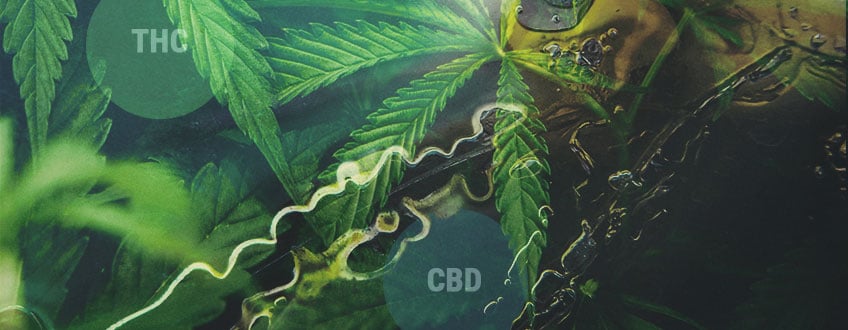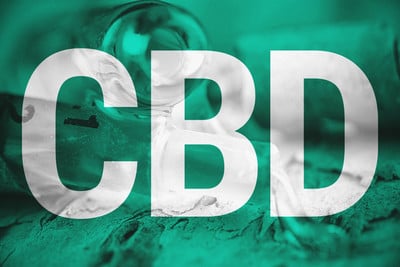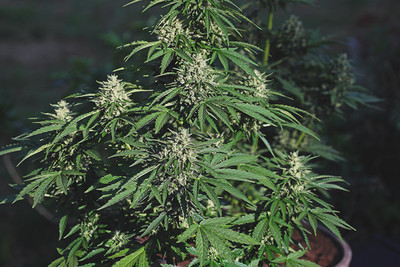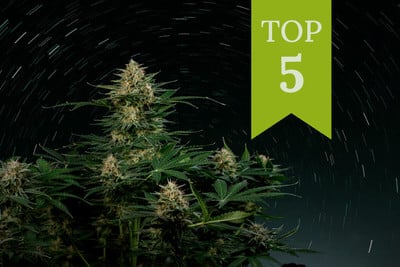How THC And CBD Are Made: Understanding The Cannabinoid Pathway
Most growers have one ultimate goal: to produce big, beautiful buds with the highest possible amount of THC or CBD. It's common knowledge that potency peaks at a certain point then gradually diminishes over time. Harvest too early or too late, and all your hard work could be for naught.
But how does cannabis create the most desired cannabinoids? Your plants aren't just relaxing as they bask under all that light. An incredible amount of work is being done at a molecular level. Let's take a closer look at the cannabinoid biosynthetic pathway.
Contents:
CBGA AND CBGVA: WHERE IT ALL STARTS
Before cannabis plants produce any cannabinoids, they produce a chemical called geranyl pyrophosphate. When that substance binds with olivetolic acid, cannabigerolic acid or CBGA is created. If it binds with divarinolic acid, on the other hand, cannabigerovarinic acid CBGVA is formed.
This is where all future cannabinoids start. Without these building blocks, you'd never have any THC or CBD.
CBGA's molecular structure is C₂₂H₃₂O₄—that's 22 carbon molecules, 32 hydrogen molecules, and 4 oxygen molecules. CBGVA has a similar molecular structure of C₂₀H₂₈O₄, with fewer carbon and hydrogen atoms. Remember those numbers because future cannabinoids will have a very similar formula. They may lose a few atoms, but most of the differences between each cannabinoid are caused by their specific arrangement of atoms.
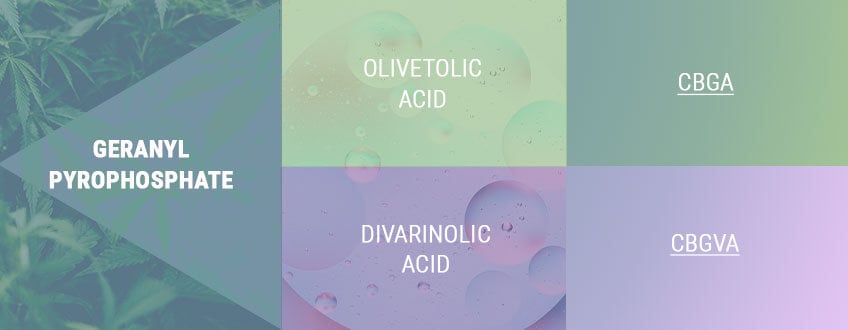
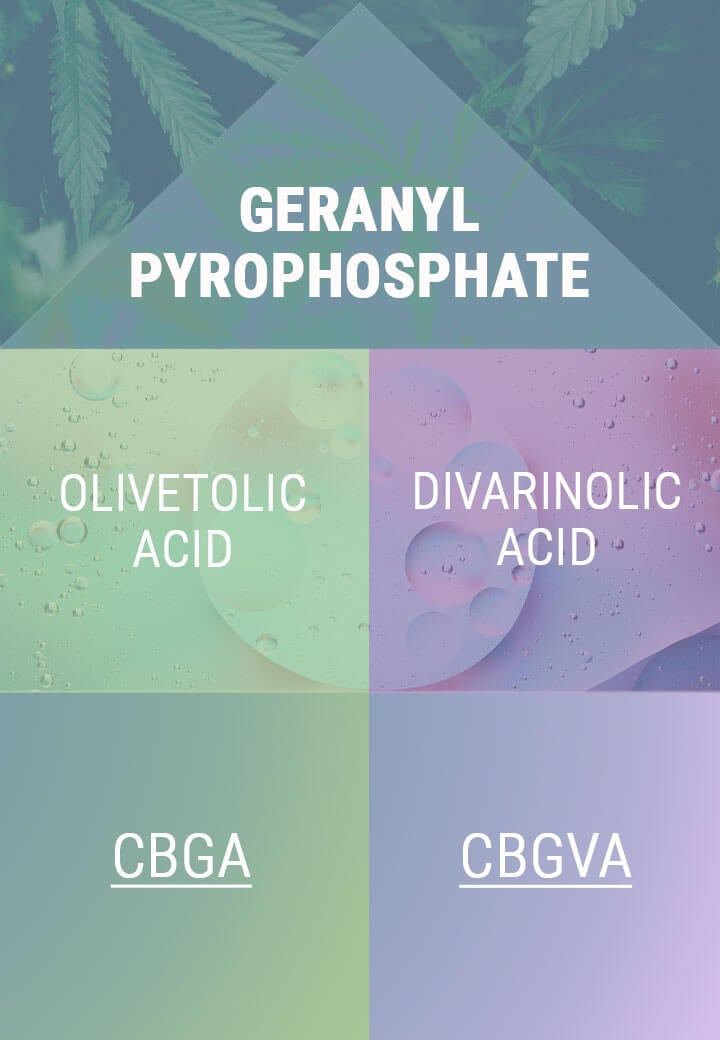
BIOSYNTHESIS CREATES THE ACID FORMS OF THE PRIMARY CANNABINOIDS
When CBGA and CBGVA are combined with specific enzymes (acid-based synthases), they change through biosynthesis into the acid form of one of the three primary cannabinoids: THC, CBD, and CBC. Note that the new molecular formulas are very similar to CBGA and CBGVA, but each new cannabinoid has lost a few hydrogen atoms. All of the carbon and oxygen atoms are still there:
- CBGA + THCA-synthase = THCA or tetrahydrocannabinolic acid
- CBGA + CBDA-synthase = CBDA or cannabidiolic acid
- CBGA + CBCA-synthase = CBCA or cannabichromenic acid
- CBGVA + THCA-synthase = THCVA or tetrahydrocannabivarinic acid
- CBGVA + CBDA-synthase = CBDVA or cannabidivarinic acid
- CBGVA + CBCA-synthase = CBCVA or cannabichromevarinic acid
THCA, CBDA, and CBCA all have the same molecular formula of C₂₂H₃₀O₄. So do THCVA, CBDVA and CBCVA at C₂₀H₂₆O₄. However, the atoms are arranged differently, and that accounts for their different traits.
Even though THCA and THCVA sound a lot like THC, they are still not very psychotropic and won't get you high until they're converted in the next stop in the cannabinoid pathway. At that point, all of these cannabinoids will take on their active form.
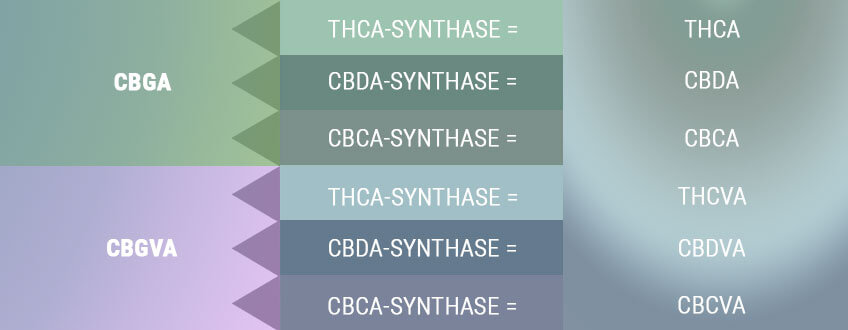
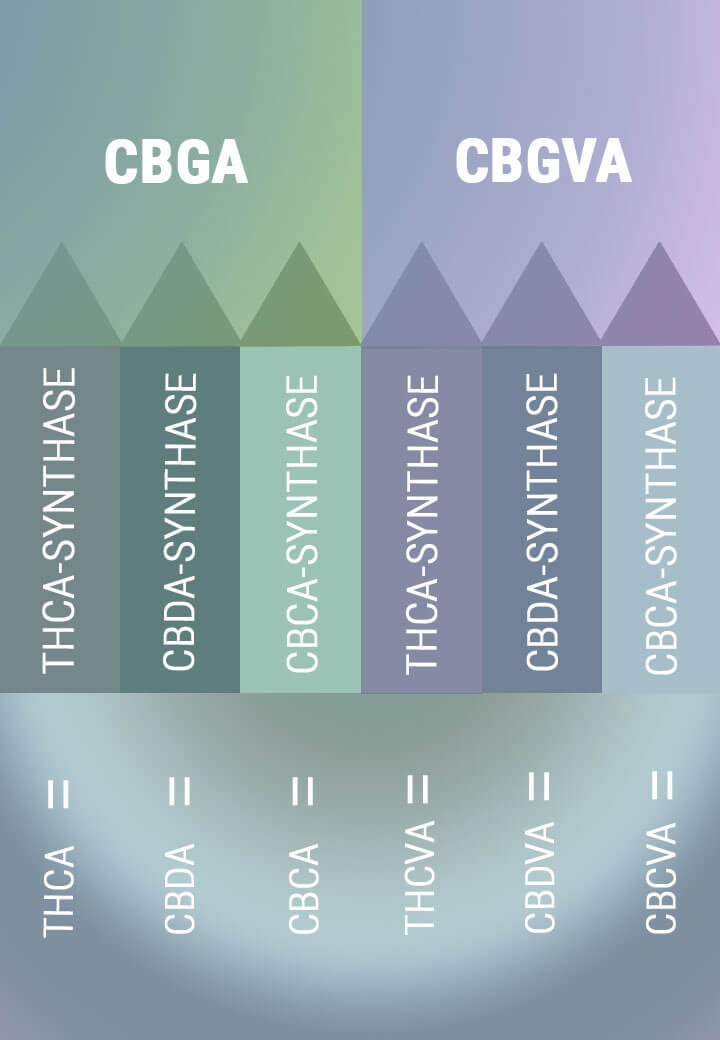
DECARBOXYLATION CHANGES ACIDS TO ACTIVES
Even if cannabis is cut at peak harvest time, it still contains very few active cannabinoids. At this point, they're still in their acid form at the molecular level. That's why eating raw weed doesn't get you high. It has to be decarboxylated (decarbed) for the cannabinoids to take on their active form.
Curing over time will partially decarb your herb, but heat does a more complete job. This process happens instantly when you're smoking or vaping, but not when making edibles. That's why most recipes recommend that you decarb in the oven first before cooking.
So, what does decarboxylation actually do at the molecular level? It removes one carbon atom and two oxygen atoms from each molecule. That's why "carb" and "oxylate" are part of the word.
For THC, you should heat your dried cannabis in the oven at 120°C for at least 20–30 minutes when cooking or making extracts. If you want to preserve terpenes, heat for a longer time at a lower temperature. For CBD, turn the oven up to 140°C and extend the time to 60–90 minutes.
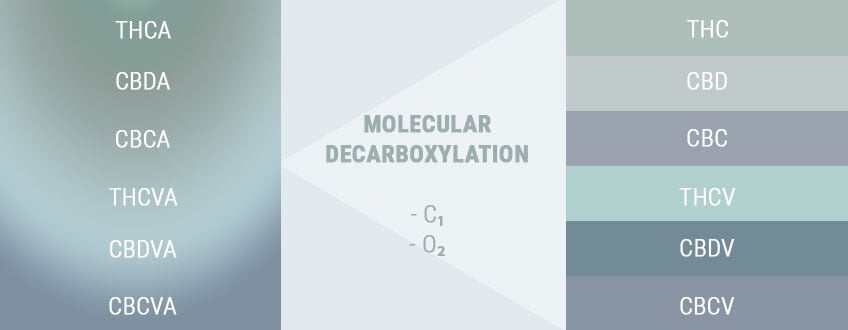
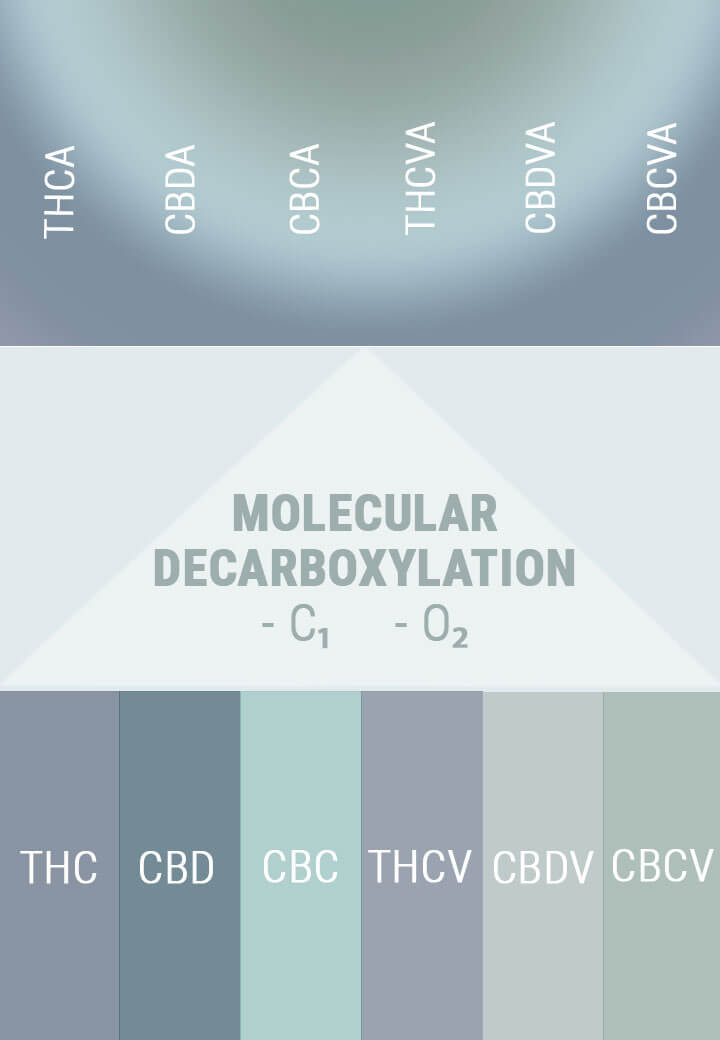
When you're done, these will be your new cannabinoids:
- THC or tetrahydrocannabinol
- CBD or cannabidiol
- CBC or cannabichromene
- THCV or tetrahydrocannabivarin
- CBDV or cannabidivarin
- CBCV or cannabichromevarin
Once again, the molecular formulas are the same, but the structure and arrangement of atoms make the cannabinoids have very different effects. THC, CBD, and CBC's molecular formula is C₂₁H₃₀O₂. THCV, CBDV, and CBCV's is C₁₉H₂₆O₂.
WHAT ABOUT PLAIN OLD CBG?
By the time plants are mature, the vast majority of CBGA is transformed into THCA, CBDA, and CBCA. What little bit is left changes to cannabigerol or CBG (no A or VA) when heat is applied. This makes CBG differ from THC by two additional hydrogen atoms.
It can get confusing, so here's a summary of these three very similar formulas:
- CBGA: C₂₂H₃₂O₄
- THC: C₂₁H₃₀O₂
- CBG: C₂₁H₃₂O₂
Again, these transformations include more than the loss of a few atoms. The rearrangement of the remaining atoms creates completely new, although closely related chemical compositions with very different properties from any other unique cannabinoid.
CBG is an active, minor cannabinoid that hasn't been studied very much to date, but it is believed to have numerous potential health benefits including pain relief and cancer-fighting properties. However, like CBD, it's not noticeably psychotropic and won't give you a traditional high. If you want to try using herb that's high in CBG, harvest about 2–3 weeks before peak ripeness.
DEGRADATION OVER TIME DOES THE REST
Leave cannabinoids to their own devices and they'll change again with time and exposure to the atmosphere. This is called degradation. It can happen while still on the plant if you wait too long to harvest, or with cured weed when it's not stored properly. Degradation weakens even the most potent bud as the active cannabinoids convert over to their less desirable chemical forms.
You can actually see the THC change over to CBN or cannabinol if you look at the trichomes. The degradation happens as the color goes from milky to amber. CBN has some mild psychoactivity, but the effect is more narcotic than euphoric. If you're looking for a more couchlocking stone, you could experiment by delaying your harvest on a single plant until most of the crystals have changed color.
The change from THC to CBN only requires the deletion of four hydrogen atoms to take the formula from C₂₁H₃₀O₂ to C₂₁H₂₆O₂. To go from CBD to CBE or cannabielsoin, on the other hand, the formula changes in a different way. The cannabinoid actually picks up an oxygen atom, changing to C₂₁H₃₀O₃.
To make sure your cannabis degrades as slowly as possible, you should control these four conditions:
- Temperature: Store herb at 20°C or less
- Humidity: Keep the relative humidity in your storage area at around 60%
- UV Light: Store your weed in a dark area away from direct sunlight
- Oxygen: Airtight containers that restrict airflow prevent further oxidation
As a plant product, cannabis is, after all, perishable just like other fruits and vegetables. When stored properly, it has a long shelf life. Extracts seem to keep their potency a little longer, but the cannabinoids in your concentrates will eventually degrade as well.
THE CANNABINOID PATHWAY—IN CONCLUSION
Who would have ever guessed cannabis plants were working so hard at a microscopic level? They could be doing even more that we haven't discovered yet. The scientific world is revealing more about these magical plants every day. The only thing we know for certain is that there's much more to learn.


























